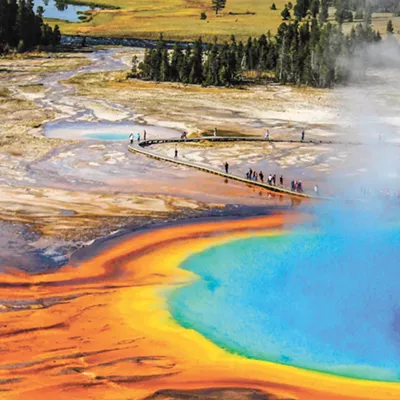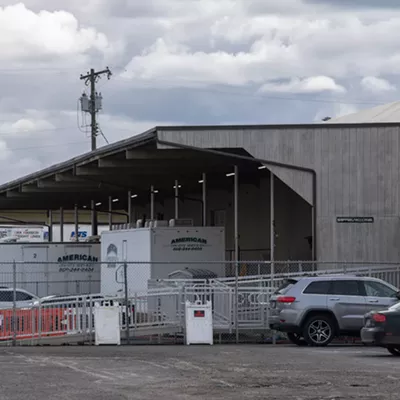Last November, Spurgeon, assistant secretary for nuclear energy, assured the congressional Committee on Energy and Natural Resources that the program will "promote a significant, wide-scale use of nuclear energy in a safe and secure manner ... while decreasing the risk of nuclear weapons proliferation and effectively addressing the challenge of nuclear waste disposal."
It's been three decades since a nuclear power plant has been built in the United States. Now, under the 2005 Energy Policy Act, the Energy Department is working hard to lure new proposals, adding billions in tax breaks and"cost overrun guarantees" and streamlining its licensing process with four ready-to-use designs, early site permits and a combined construction permit and operating license. The 104 nuclear power plants currently in the U.S.generate about 20 percent of the nation's electricity. Some Energy Department plans call for as many as 50 new nuclear plants by 2020, producing 50,000 megawatts. Twenty-two applications are currently on file with the Nuclear Regulatory Commission, including proposals for plants in Utah and Idaho.
Nuclear weapons development is ramping up as well, with a budget next year of $6.6 billion. At $25 billion, the 2009 DOE's budget request is $5 billion more than 2008. Meanwhile, the cleanup budget has plummeted for the fifth year in a row, dropping $1 billion in just the past three years, according to Jane Hedges, Washington state's nuclear waste program manager. "We thought that was telling," she says. The cuts have left many Western sites, including Hanford and the Idaho National Laboratory, facing setbacks in the dangerous and complicated mop-up of this country's nuclear messes. Washington state has even threatened to sue the DOE for failing to meet the terms of the Hanford cleanup agreement.
Now considered the most contaminated site in the nation, Hanford --established in 1943 as part of the Manhattan Project -- produced plutonium for nuclear weapons for more than 40 years. The 586-square-mile property in south central Washington once hosted nine nuclear reactors, five chemical separation plants and hundreds of support facilities. By 1987, all of the reactors were closed except the Columbia Generating Station, the only commercial nuclear power plant in the Northwest. The site has more than 170 massive underground steel tanks filled with acids, solvents and heavy metals, including the radioactive elements plutonium, cesium, strontium and uranium. Some 140 of the tanks are single-walled, 40 to 60 years old and "unfit for use." The original agreement called for the tanks to be cleaned out within several decades, says Hedges. But at current funding levels, with an $8 billion cleanup budget shortfall over 10 years, it will take more than a century to empty them.
On top of the 53 million gallons of tank waste, untold amounts of radioactive and hazardous waste languish in unlined landfills, along with450 billion gallons of liquid waste in ponds, ditches and drain fields. The site has already contaminated 200 square miles of groundwater.
& lt;span class= & quot;dropcap & quot; & A & lt;/span & state away, failing tanks at the Idaho National Laboratory are leaking radioactive waste generated from nuclear weapons production into the groundwater. Chromium, tritium and other contaminants have already been detected in the Snake River Plain aquifer, the sole drinking water source for more than 300,000 residents of Idaho. Rep. Mike Simpson (R-Idaho), fears budget shortfalls will only make things worse, leading to spills of PCBs, uranium, plutonium and hazardous chemicals, and preventing necessary equipment maintenance. Simpson, with about two dozen House colleagues, is part of the Nuclear Cleanup Caucus initiated by Doc Hastings (R-Wash.) in the mid-1990s. The bipartisan group and its Senate counterpart are currently stumping for more cleanup money. Meanwhile, permit changes at the Waste Isolation Pilot Plant in New Mexico have postponed shipments from Idaho and added to costs. And one long-planned "solution" to the problem -- the proposed Yucca Mountain repository 90 miles northwest of Las Vegas -- is beset with legal, logistic and budgetary challenges. It will not open for at least another decade, if ever.
But nuclear advocates, including some prominent enviros, believe the waste issue is solvable. "It is incorrect to call it waste," writes former Greenpeace activist Patrick Moore, now a nuclear industry spokesman, "because 95 percent of the potential energy is still contained in the used fuel after the first cycle. Now that the United States has removed the ban on recycling used fuel, it will be possible to use that energy and to greatly reduce the amount of waste that needs treatment and disposal."
Reprocessing produces waste that is intensely radioactive, toxic, thermally hot and difficult to contain, counters Susan Gordon, director of the Santa Fe, N.M.-based Alliance for Nuclear Accountability. And, she says, costs keep rising; this year, DOE estimated cleanup costs at $225 billion, $100billion more than last year. Sites that were to be completed by 2035 are now delayed to 2040 or even decades later, she adds, and some sites where cleanup is in progress (including Sandia and Los Alamos in New Mexico) are also gearing up to produce a new generation of nuclear weapons.
"As a result, cleanup becomes an ever more expensive, never-ending activity," says Gordon. "Despite years of trying to come up with a solution to high-level waste, at huge cost, nothing has been disposed of."
totheeditor@inlander.com
This story first appeared in High Country News.















